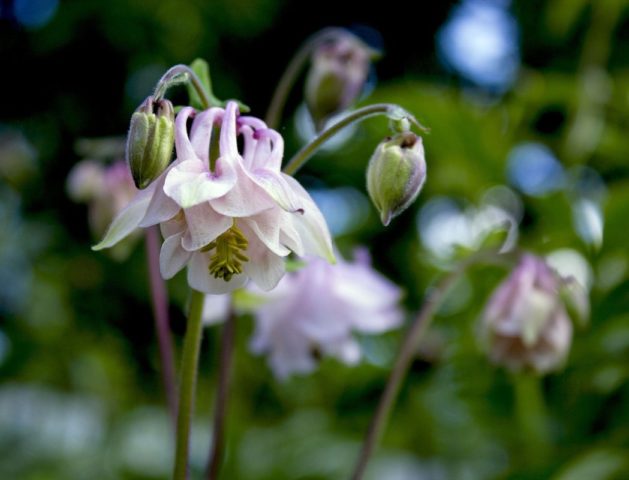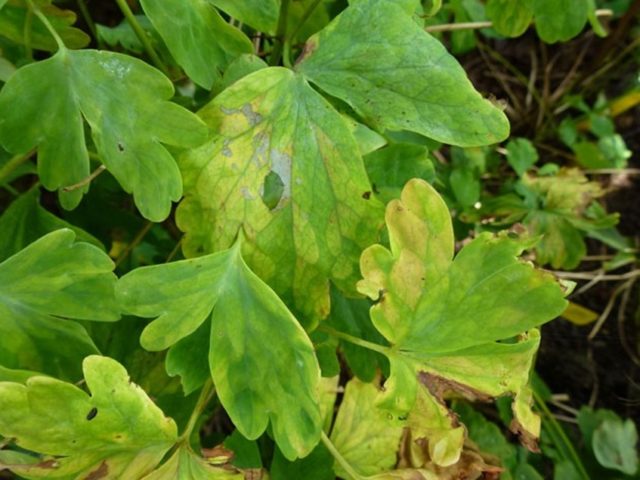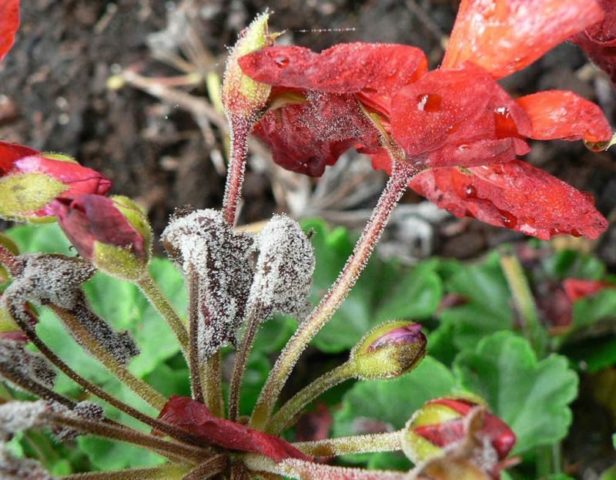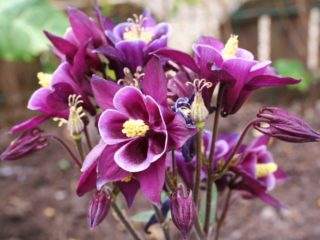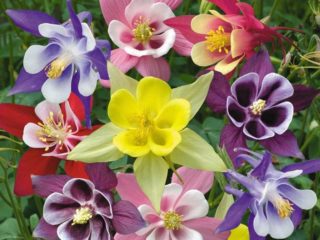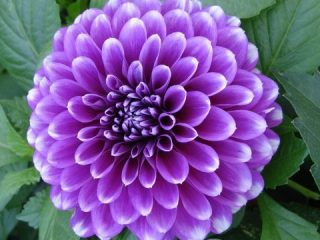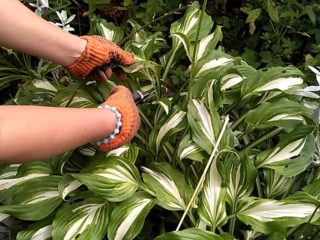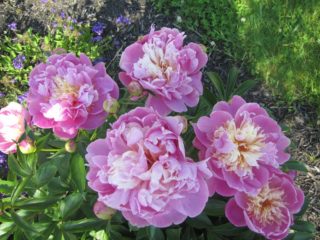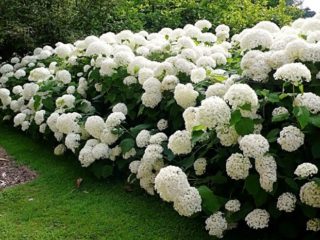Content
Aquilegia terry belongs to the perennial flowering shrubs of the Ranunculaceae family and has more than 100 varieties. The plant also has alternative names - columbine, elf flower, orlik, etc. The unusual shape and unpretentiousness in maintenance make terry aquilegia one of the most common species among gardeners.
Aquilegia terry is a spreading shrub that reaches 1 m in height. This is a plant with a strong, well-developed root system, the size of which often does not exceed 1 m. The stems have round, lace-shaped leaves, similar in appearance to clover. The large flowers of the shrub bend towards the ground and reach up to 10 cm in length.
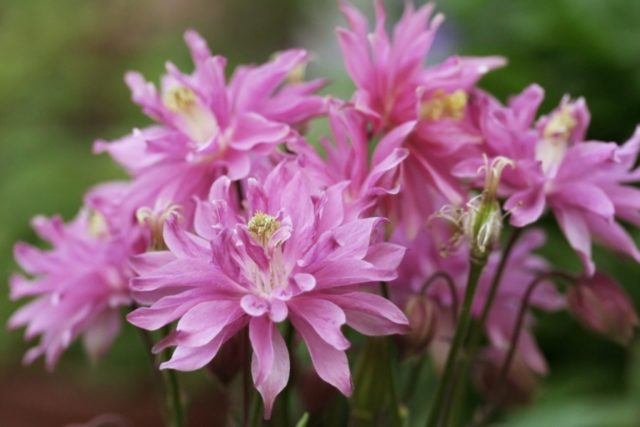
Most flowers have elongated growths - spurs, which are necessary for collecting nectar
Aquilegia terry has a rich range of colors; the color of one flower can consist of several shades. The habitat of the plants is the Caucasus, Altai, Crimea, and the Far East.
Varieties and varieties
Aquilegia terry has a large number of varieties.Each variety has its own characteristic characteristics, due to which the shrub is actively used for decorating summer cottages and garden plots.
Nora Barlow
The main distinguishing feature of the Nora Barlow terry aquilegia variety is its large double white-pink (or white and red) flowers with a dark core.
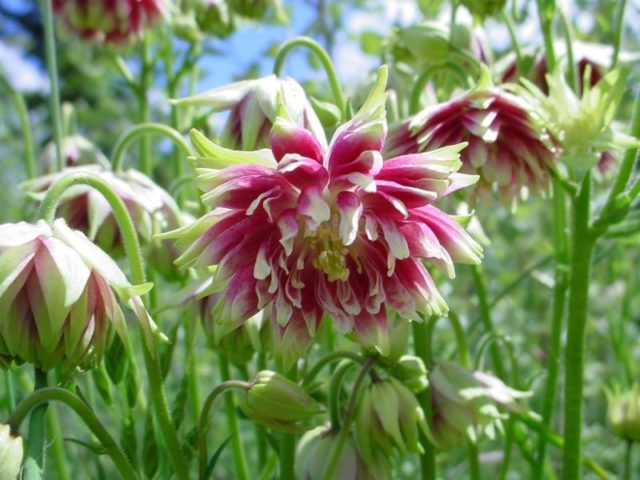
Nora Barlow reaches up to 70 cm in height and has a spreading shape.
Hybrid
Hybrid aquilegia (lat. Aquilegia hybrida) is actively used in landscape design due to its large bright inflorescences that resemble pink asters in appearance. One bush can contain more than 5 flowers.
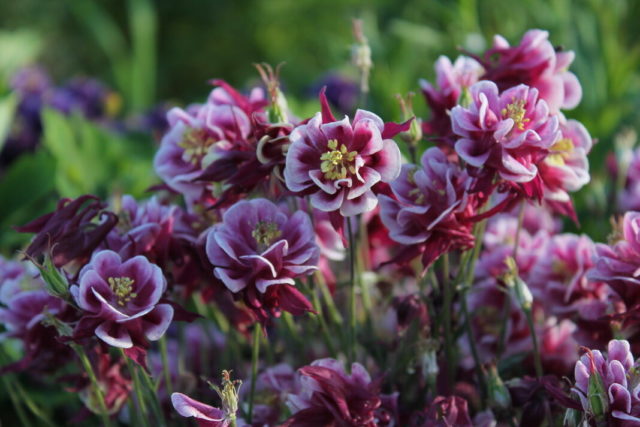
The variety also has an interesting feature - the flowers often lack spurs (growths on the petals)
Mac Canna
Aquilegia terry variety McKana Giant is also called the “giant in landscape design”: the shrub can reach up to 120 cm in height. It has long spurs and erect buds.
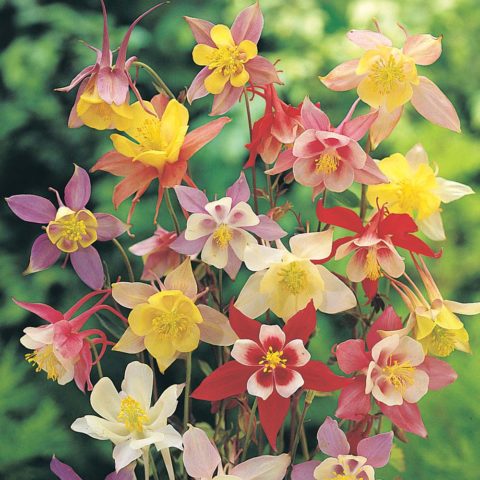
Mac Canna has a wide range of colors
Columbine
The Columbine variety (lat. Aquilegia Vulgaris) is characterized by a high level of cold resistance. The shrub often does not exceed 70 cm in height, grows well and develops in partial shade.
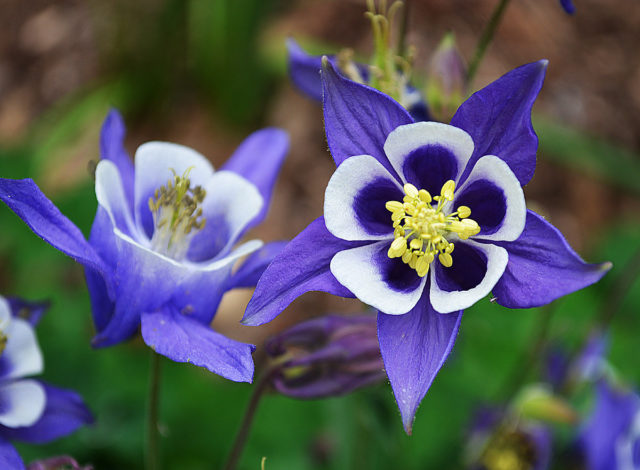
Columbine flowers reach 6 cm in diameter
Winky
Aquilegia Winky is considered one of the most popular varieties.
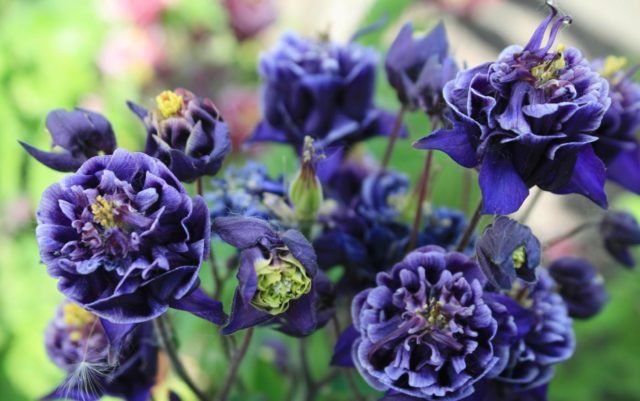
Vinka shrubs are actively used both in the field of landscape design and for creating floral compositions
This is a dwarf variety, the height does not exceed 30 cm. It has many color options.
Application in landscape design
Tall varieties of terry aquilegia are combined in landscape compositions with irises, hosts, bells or poppies.

Low-growing types of aquilegia are used to decorate alpine slides and rockeries; the combination with carnations looks good
Shrubs are placed with spruce and fir trees, and some landscape designers plant aquilegia near the pond. In flower arrangements you can also find a combination of different varieties of elf flower.
Features of reproduction
For terry aquilegia, there are several options for propagation at home:
- Seeds or seedlings. This method of growing plants is not very popular due to the low probability of obtaining sprouts with all varietal genetic characteristics. Seeds are planted both in special containers (if you need to get seedlings) and in a permanent place. Future plants need to be provided with abundant watering, as well as a greenhouse effect. When the first shoots appear, it is allowed to remove the protective cover. Seedlings can be picked only after 3-5 leaf blades have formed.
- Dividing the bushA. This method is one of the most popular among beginning gardeners. However, extreme care should be taken so as not to harm the mother plant. It must be removed from the ground and the root system divided into the required number of parts. For the procedure it is necessary to use special sharp gardening tools. It is important that each separated part has at least 3 healthy buds. Important! For division, only specimens over 5 years old can be used.
- Cuttings. To obtain young plants, the required number of shoots is cut from the mother bush in early spring. Then the collected planting material is placed in a growth stimulator for 3-4 hours.Plants should only be planted in pre-fertilized soil. To help the root system form faster, you can create a small polyethylene greenhouse around them. When new leaf blades appear, the seedlings can be transplanted to a permanent location.
Cuttings are considered the most common method of propagating aquilegia.
Planting and caring for terry aquilegia
The culture is distinguished by its unpretentiousness in maintenance and requires minimal simple care. Despite this, before purchasing terry aquilegia for your garden plot, it is important to carefully read the photo of the selected flower and the features of its cultivation.
Deadlines
If you grow terry aquilegia using the seed method, the plant will begin to bloom only after 3 years. In order for flowers to appear in the second year of growth, the seeds must be placed in boxes in early March. In this case, the sprouts must be in the house or greenhouse.
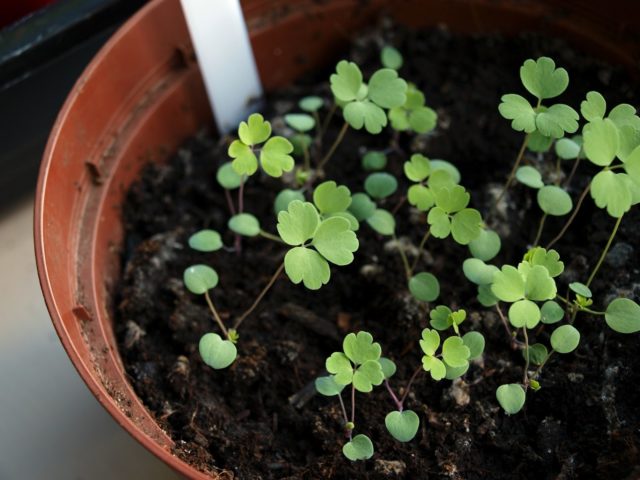
Plants should be planted in the ground only when stable warm weather arrives.
Before the onset of cold weather, terry aquilegia should get stronger and grow in greenhouse conditions, then it will be ready for flowering next year. The crop is rarely sown, without burying the seeds deep into the ground. The optimal temperature for faster emergence is 15-20 °C.
Site selection and soil preparation
The best option for planting terry aquilegia will be an area with partial shade. In the complete absence of sunlight, the number of flowers on the bush decreases, and constant light, on the contrary, can lead to the complete death of the plant. If there is no shade on the planting area, the area must be shaded manually.
It is better that the soil is loamy and moist.Before planting aquilegia, you must carefully dig up the area and remove all weeds. Special organic fertilizers should also be added to the soil first. It is important to ensure that the distance between plants is at least 20 cm.
Landing algorithm
As mentioned above, the most common methods of growing aquilegia are planting using seeds or seedlings.
Planting by seed method occurs in the spring, after the snow cover has completely melted and consists of the following stages:
- Preparing the territory: choosing a planting site, cleaning the soil from weeds.
- Placing seeds in the ground.
- Covering the planting material with soil (no more than 1.5 cm).
- Adding a small amount of water.
- Mulching the soil using humus or peat.
At the beginning of June, seedlings must be placed in prepared soil at a distance of 20-25 cm from each other. It is important to do this carefully so as not to damage the delicate root system of young plants.
Watering and fertilizing schedule
Aquilegia terry needs regular moistening, but do not completely flood the plant with water. Watering the shrub is recommended as the top layer of soil dries out. Gardeners also advise using irrigation tools to simulate rain (the leaves of the plant absorb raindrops well). During natural precipitation, there is no need to additionally water terry aquilegia.
The ideal time to add organic or mineral fertilizers to the planting soil is considered to be rainy or simply cloudy weather. In sunny and dry periods, aquilegia should be fed in combination with watering in the evening. After this, the plant needs to be shaded for 1 day.Fertilize the shrub in May-June, as well as after flowering.
Weeding and loosening
It is necessary to loosen the soil under aquilegia after each watering or precipitation by no more than 20 cm. This is necessary so that oxygen does not stagnate in the soil. Don’t forget about weeding the area every time weeds appear in the garden bed.
Care during the flowering period
Caring for aquilegia during the flowering period is not difficult. It includes loosening the soil, as well as fertilizing the bushes with organic and mineral complexes. When flowering ends, the flower stalks are cut off at the level of the lower leaves. The average lifespan of a shrub is from 5 to 7 years. Then it is better to replace it with a young specimen.
Wintering
Aquilegia terry is characterized by a high level of winter hardiness. However, when the plant reaches the age of 5 years, its root system begins to make its way to the surface. Therefore, the shrub needs to provide additional shelter in winter. To do this, the crop is mulched with humus and peat compost, and then sprinkled with fresh soil.
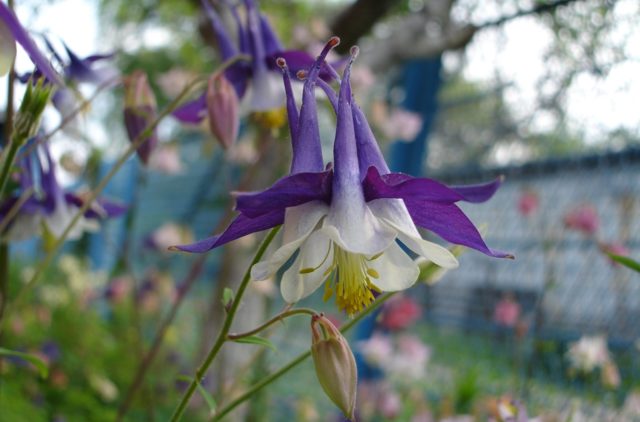
You need to start preparing shrubs for wintering in mid-autumn
Diseases and pests
Aquilegia terry has an average level of disease resistance and can be susceptible to the following infections:
- Powdery mildew. This disease occurs when there is a lack of sunlight, as well as when there is an increased level of moisture. For prevention, the plant should be treated with a sulfur solution.
Folk and chemical remedies are used for treatment
- Mosaic. It is considered one of the most dangerous incurable diseases.
If symptoms of the disease appear on the bush, the infected specimen should be immediately dug up and burned to avoid transmission of infection.
- Gray rot. In the first stages of infection, the bush can be cured with Fundazol.
In case of advanced disease, the plant is dug up and burned.
Pests of the eagle are aphids, caterpillars, and mites. To get rid of insects, you can use both traditional and chemical preparations. It is important to notice the symptoms of damage to the bush in time, otherwise it may die in just a few days.
Conclusion
Aquilegia terry is a shrub up to 1 m tall with large beautiful inflorescences. The culture has many varieties and is widely used in landscape design to decorate the area and create individual compositions. The plant is unpretentious in care, has a high level of winter hardiness and perfectly adapts to partial shade. To properly maintain the orlik, it is important to water the crop in a timely manner, regularly apply fertilizers, weed, mulch and loosen the soil, and do not forget about protection in winter.
